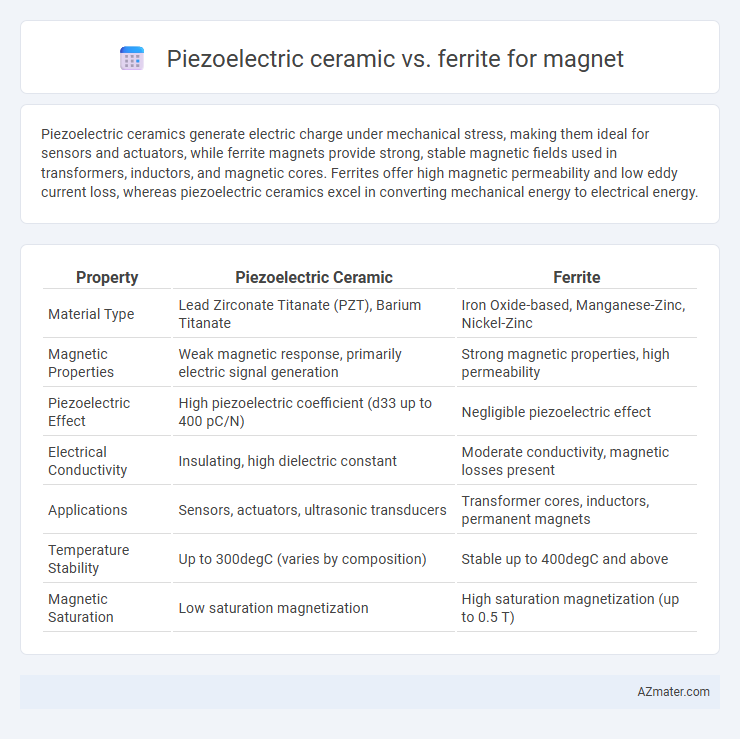Piezoelectric ceramics generate electric charge under mechanical stress, making them ideal for sensors and actuators, while ferrite magnets provide strong, stable magnetic fields used in transformers, inductors, and magnetic cores. Ferrites offer high magnetic permeability and low eddy current loss, whereas piezoelectric ceramics excel in converting mechanical energy to electrical energy.
Table of Comparison
| Property | Piezoelectric Ceramic | Ferrite |
|---|---|---|
| Material Type | Lead Zirconate Titanate (PZT), Barium Titanate | Iron Oxide-based, Manganese-Zinc, Nickel-Zinc |
| Magnetic Properties | Weak magnetic response, primarily electric signal generation | Strong magnetic properties, high permeability |
| Piezoelectric Effect | High piezoelectric coefficient (d33 up to 400 pC/N) | Negligible piezoelectric effect |
| Electrical Conductivity | Insulating, high dielectric constant | Moderate conductivity, magnetic losses present |
| Applications | Sensors, actuators, ultrasonic transducers | Transformer cores, inductors, permanent magnets |
| Temperature Stability | Up to 300degC (varies by composition) | Stable up to 400degC and above |
| Magnetic Saturation | Low saturation magnetization | High saturation magnetization (up to 0.5 T) |
Introduction to Magnetic Materials
Piezoelectric ceramics exhibit strong electromechanical coupling, enabling precise control in sensors and actuators, whereas ferrite magnets provide high magnetic permeability and low eddy current losses, essential for efficient transformers and inductors. Ferrite materials, typically composed of iron oxide mixed with barium or manganese, offer excellent magnetic stability and resist corrosion, making them ideal for high-frequency applications. In contrast, piezoelectric ceramics, such as lead zirconate titanate (PZT), generate electric charge in response to mechanical stress but do not maintain permanent magnetization like ferrites.
Overview of Piezoelectric Ceramics
Piezoelectric ceramics are advanced materials that generate electric charge under mechanical stress, making them essential for sensors and actuators in precision applications. Unlike ferrite magnets, which rely on magnetic properties for electromagnetic devices, piezoelectric ceramics exhibit strong electromechanical coupling and high-frequency response. Their versatility and sensitivity enable integration in ultrasonic transducers, energy harvesting systems, and microelectromechanical systems (MEMS).
Ferrite: Composition and Types
Ferrite magnets are primarily composed of iron oxide (Fe2O3) combined with barium or strontium carbonate, forming either barium ferrite (BaFe12O19) or strontium ferrite (SrFe12O19). These ceramic magnets exhibit a hexagonal crystal structure that provides high coercivity and moderate magnetic strength. Common types include hard ferrites used in permanent magnets for motors, speakers, and magnetic separators due to their excellent corrosion resistance and cost-effectiveness.
Magnetization Mechanisms: Piezoelectric Ceramic vs Ferrite
Piezoelectric ceramics generate magnetization through the direct coupling of mechanical stress and electric polarization, enabling precise control of magnetic properties via applied voltage. Ferrite magnets rely on electron spin alignment and magnetic domain interactions driven by intrinsic magnetic anisotropy, resulting in strong, stable magnetization without external input. The fundamental difference lies in piezoelectric ceramics' voltage-induced magnetization versus ferrites' spontaneous magnetic ordering from electron exchange interactions.
Magnetic Performance Comparison
Piezoelectric ceramics exhibit lower magnetic permeability and weaker magnetic performance compared to ferrite magnets, which are specifically engineered for strong magnetic fields. Ferrite magnets deliver high coercivity and remanence, making them ideal for applications requiring stable and robust magnetic properties. The magnetic flux density of ferrite materials typically surpasses that of piezoelectric ceramics, resulting in superior magnetic efficiency and performance.
Frequency Response and Applications
Piezoelectric ceramic magnets exhibit a higher frequency response, typically operating effectively in the range of kilohertz to megahertz, making them ideal for ultrasonic sensors, actuators, and precision vibration control applications. Ferrite magnets, on the other hand, provide strong magnetic fields at lower frequencies, usually up to a few kilohertz, and are commonly used in transformers, inductors, and low-frequency electromagnetic devices. The choice between piezoelectric ceramics and ferrite magnets depends on the required frequency range and specific application needs, with piezoelectrics suited for high-frequency applications and ferrites preferred for cost-effective, low-frequency magnetic solutions.
Efficiency and Energy Losses
Piezoelectric ceramic magnets exhibit higher energy conversion efficiency due to their ability to directly convert mechanical stress into electrical signals with minimal energy loss. Ferrite magnets generally have lower efficiency in dynamic applications because of higher hysteresis and eddy current losses, which increase energy dissipation during magnetization cycles. The superior electromechanical coupling coefficient of piezoelectric ceramics reduces energy losses, making them more suitable for precise sensing and energy harvesting compared to ferrite magnets.
Durability and Environmental Stability
Piezoelectric ceramics exhibit superior durability compared to ferrite magnets, maintaining consistent performance under mechanical stress and high-frequency vibrations. These ceramics also offer enhanced environmental stability, resisting temperature fluctuations and moisture more effectively than ferrite materials. Ferrite magnets tend to suffer from brittleness and corrosion, limiting their longevity in harsh conditions relative to piezoelectric ceramics.
Cost and Manufacturing Considerations
Piezoelectric ceramics generally incur higher material costs compared to ferrite magnets due to their complex manufacturing processes involving sintering and polarization treatments. Ferrite magnets benefit from lower raw material expenses and simpler production techniques like powder pressing and sintering, making them more cost-effective for mass production. Manufacturing considerations for piezoelectric ceramics include precise control of electrical properties and quality assurance, whereas ferrite magnets emphasize volume efficiency and mechanical robustness.
Choosing the Right Material for Specific Magnet Applications
Piezoelectric ceramics offer high sensitivity and stable performance in sensor and actuator applications, making them ideal where precise electrical charge generation or mechanical strain detection is required. Ferrite magnets excel in low-cost, high-resistance environments with moderate magnetic strength, commonly used in loudspeakers, motors, and transformers due to their excellent magnetic permeability and electrical resistivity. Selecting between piezoelectric ceramic and ferrite depends on the application's need for either electromechanical coupling efficiency or magnetic field strength and durability under thermal or corrosive conditions.

Infographic: Piezoelectric ceramic vs Ferrite for Magnet
 azmater.com
azmater.com